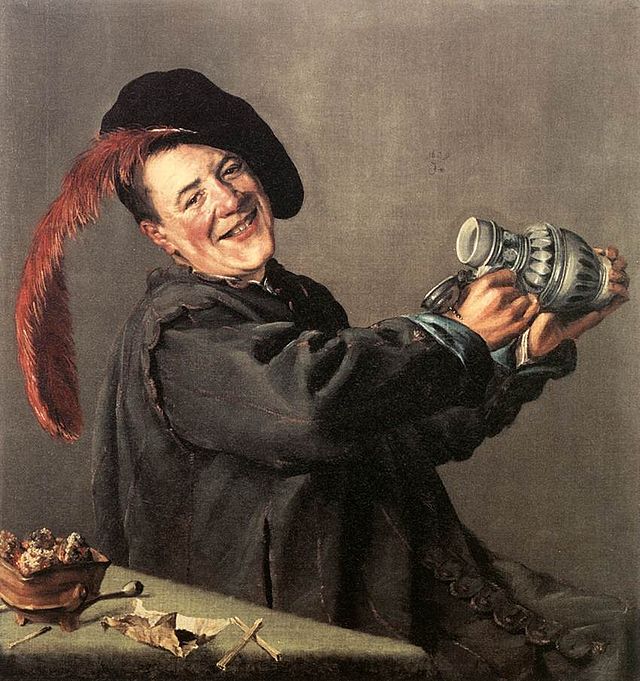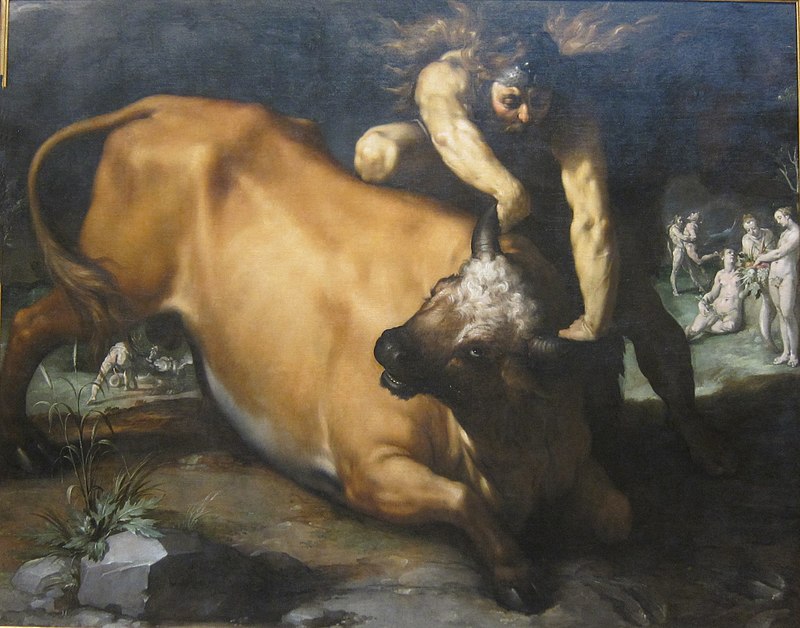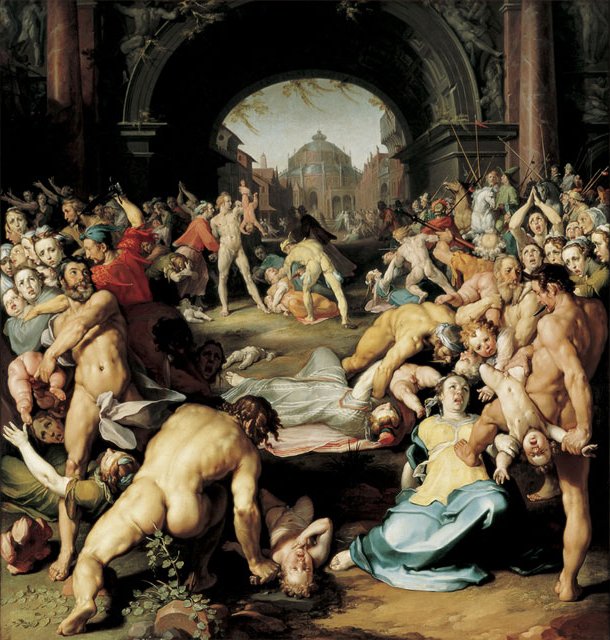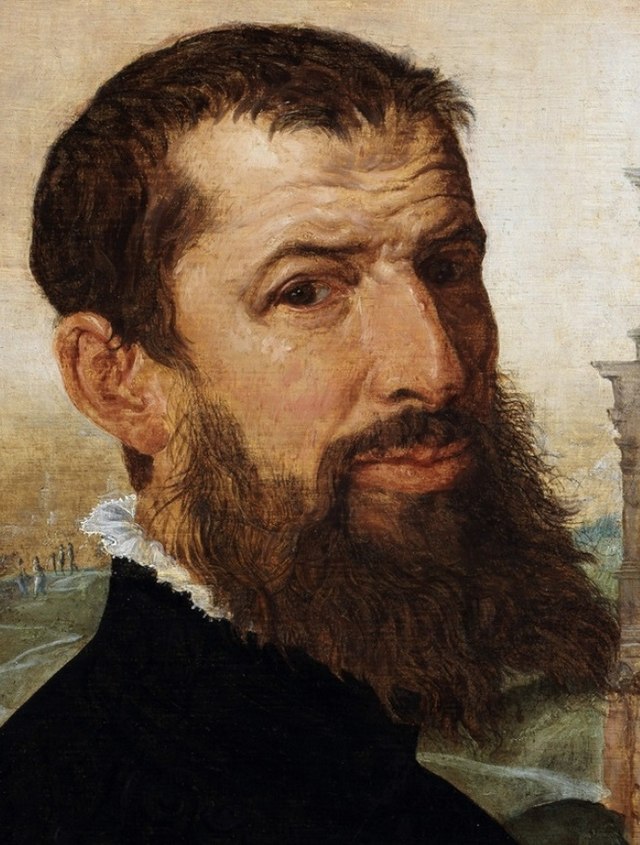
Pekelharing, “The Jolly Toper”, Judith Jansdr Leyster (1629)
Living in a foreign place is when it can actually be the hardest to get out and see it but I got a chance to return to a lovely museum (because of a lovely person): the Fans Hals Museum. I’ve had to put my project on a brief hold to take care of life (much to my frustration…grrr…i’m so happy with my application and want to bring it to closure…anyway) but it can be good to clear the head. once in a while.
I say it all the time: I’m a fan of staying in museums only as long as you feel like it, but this place is worth a good visit. Just the old clocks and various period stuff (including lovely wall tiling in places) and the building itself make it worth it. Of course, also the paintings. 😀

Cornelis Corneliszoon van Haarlem, Hercules and Achelous (1590)
I loved everything in the museum, really, but it all becomes much stranger to me over time. My fascination, lately, is Judith Leyster but seeing people like Hals, Vroom and Verspronck together in light of what came before and after, it’s clear they were competitive and sharing and stealing ideas, but also their work can present difficulties in comprehending the work the preceded them.
That long, nutso fascination with the human form in every imaginable (and horrible) pose. It was serious fireworks and technological virtuosity to total excess and bizzaro-land, but it wasn’t, of course, just in Holland: much of it was coming from Italy. So there’s like all kinds of cultural clash in the style and subject.

The Massacre of the Innocents (1591), Cornelius van Haarlem
For the moment, until virtual reality becomes reality, the context and the real thing is just not reproducible. At first, I find these paintings hard to look at – especially reproduced – and kind of ridiculous. It’s the gratuitous use of the human form. However, as a painting and when see it in context, it’s a freaking amazing, masterful and terrifying image.

Martin van Heemskerck, Self-portrait detail from his painting of the Colosseum

The Adoration of the Shepherds and Adoration of the Magi., Maerten van Heemskerck (1546/47)
This is earlier work and some of the subject matter is, um, a little tough here and definitely reflective of a very specific cultural outlook but that can be informative, if it’s contextualized and the color is so strange, to me. Alien oranges and reds, dense tonal choices and harsh, chromatic dissonances but these choices were also kind of new and, perhaps, alien to the artist as well. Wonderful, tho. When I saw it, I could see how it would be sensational at the time it was made, despite the personal discomfort at what’s being presented in the subtext.
That wobbly Northern Renaissance style mixed with a direct and kinda brutally honest subject and presentation. Somehow the character of the line seems so reflective of the place even when it gets overwhelmed with foreign ideas from other parts of Europe and the world and it can be seen everywhere in the decorative forms, including the lettering, formal flourishes, but especially the architecture. Whether conscious or unconscious, the hand reflects the person, the time and place but these paintings are also mashups from a period of change and innovation in Haarlem, becoming a bustling, Protestant city near Amsterdam.
The Arrival at Vlissingen of Frederick V, Elector Palatine (1562/1563–1640), Hendrik Cornelisz. Vroom
This painting is huge and overwhelmingly cool. All of Vroom’s work is amazing. He was an early innovator of the Dutch genre ship paintings and I feel his work contains a visionary image of the place.
My friend commented on the immediately recognizable masterfulness of Leyster, Hals and their peers but I find myself more attracted lately to the edges of where technique and style can’t hide the person and the cultural and ethical subtext is revealed. Sometimes the artist willing shows it, as I feel Leyster did maybe more than Hals, but some paintings are just wondrous for oddness and the character of a moment and a taste that makes no sense anymore (or mean something entirely different if interpreted by modern standards).
Leyster’s “The Jolly Topper” seems to oscillate between reality and unreality. There’s a specificity in the portrait and the fiction of an idealized moment against the loose, directness of the still-life on the lower left but you can see a similar kind of oscillation between real and unreal in Heemskerck’s work, too. Note figure on lower-right part of the left panel, looking outward at the viewer. It also creates a jarring moment of reality to the image.

They share an immediacy and urgency that even seeps through the acquisition of styles external to them.
Portrait of Jacobus Hendricksz Zaffius (1612), Frans Hals (question mark in wikipedia..dunno…doesn’t matter…)
It’s been said, I know, but there is always narrative being told about Art History and some works are favored over others for a kind of technique that’s readily apparent but personally…over time…I find the misunderstood “failures” of subject, style and technique are just as interesting. Maybe they look like failures or awkwardness in light of later work, which may either have been more understood in certain media or in a limited technical context or they may have been more favored in time for social and competitive reasons. They were not failures in any way and I feel their perfection can only be understood when matched with taste and expectations of a moment and a place. The space itself is, in a way, a presentation of a world-view.


Interior of the St Pieterskerk in Utrecht Pieter Jansz Saenredam 1654
When that narrative gets, sort of, “flattened” then the odd and quirky hands of the artist become more pronounced and expressive of a local narrative, bound to Haarlem and a person, independent of adopted styles or taste, but taste was becoming more cross-cultural and understood within a nascent framework in which a single painting could make you a super star. History creates weird and alien images to my modern sensibility and my understanding of technique and comprehension of it *way* after-the-fact.
I sometimes try to look at Michelangelo’s and Raphael’s work with a new eye, it’s hard but when I look at that mannered style and the proliferation and variations on it outward in Europe, it looks weird and it becomes, to me, ever more arbitrary what is deemed good. It makes me question what the underlying ethical message they communicate actually is, given today’s ethics. It’s not a criticism of their work, of course, it’s seeing it as local work made for local reasons; it’s questioning the structures which select work, and ultimately influence other artists…but some things just draw the eye…

Tulip Book, Judith Jansdr Leyster (1643)
